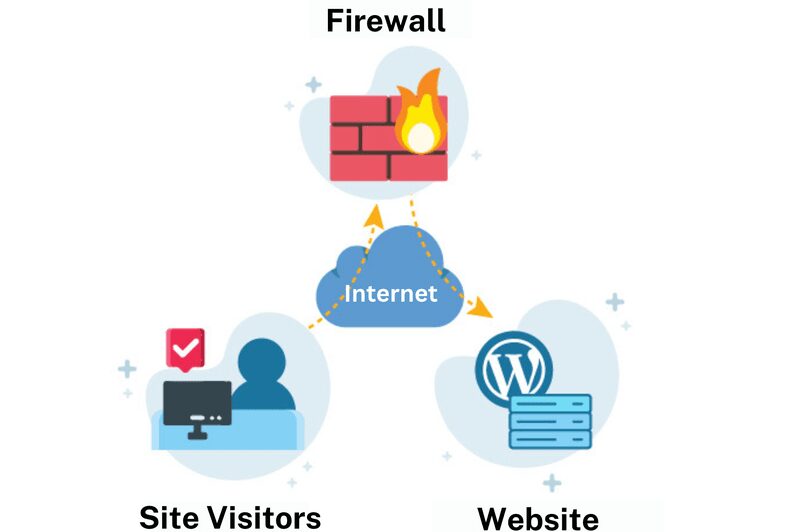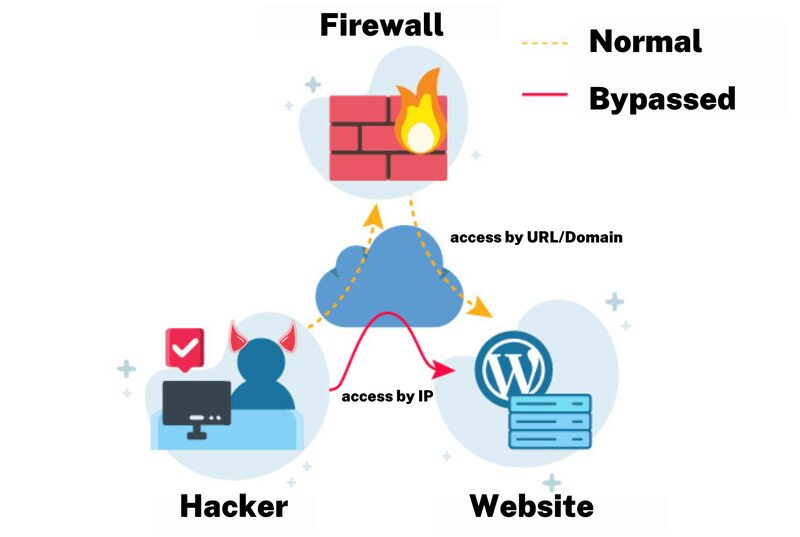WordPress-firewalls zijn webapplicatiefirewalls (WAF's) die primair zijn ontworpen om WordPress-websites te beschermen.
WAF's zijn relatief nieuw in de webbeveiligingsindustrie. Deze gids legt uit wat firewalls zijn en hoe ze WAF's werden. Het beschrijft ook de verschillende soorten WordPress-firewalls op de markt en hoe ze werken.
Het idee achter firewalls
Een firewall wordt tussen twee of meer netwerken opgezet om het inkomende en uitgaande verkeer van elk netwerk te beheren. Het dient als een barrière tussen een vertrouwd netwerk en een onbeveiligd netwerk.
Een firewall wordt doorgaans geïmplementeerd tussen een internetverbinding en een intern netwerk in een conventionele configuratie. Het wordt gebruikt om het netwerk te verdedigen tegen inkomende internetbedreigingen. Bovendien wordt het gebruikt om te reguleren wie toegang heeft tot internet. Als u thuis een wifi-router gebruikt, fungeert de router ook als firewall van uw huis. Bijna alle residentiële wifi-routers bevatten tegenwoordig een firewall.
Firewalls van de eerste generatie: pakketfiltering evolueert naar firewalls voor webtoepassingen
Firewalls waren oorspronkelijk bedoeld om netwerkverkeer te beperken en te controleren. Ze voerden alleen pakketfiltering uit en begrepen de payload van de transmissie niet. Als u een website op uw netwerk hostte, moest u poort 80 via de firewall openbaar maken.
Zodra een poort is geopend, laat de firewall alle soorten binnenkomend verkeer door, ook schadelijk verkeer.
2e generatie – Stateful filtering
De firewalls van de tweede generatie werkten op Layer 4 van het OSI-model. Dit geeft aan dat ze in staat zijn om te bepalen wat voor soort verbinding ze beheren. Bijvoorbeeld, of een pakket een nieuwe verbinding tot stand brengt of als de verbinding al tot stand is gebracht, etc.
Desondanks hebben firewalls van de tweede generatie veel problemen met het reguleren van verkeer. Beheerders zouden tenminste firewallregels kunnen definiëren op basis van de verbindingsstatus.
Applicatielaagfiltering in firewalls van de 3e generatie
De firewalls van vandaag werden halverwege de jaren 90 geïntroduceerd. Moderne firewalltechnologie is op de hoogte van protocollen en apps. Daarom kunnen firewalls van de derde generatie bepalen of de payload van een pakket voor een FTP-server is en wat het verzoek is, of dat het een HTTP-verbindingsverzoek is en wat het verzoek is.
Deze technologie leidde tot de ontwikkeling van firewalls met een beperkte reikwijdte, zoals webapplicatiefirewalls.
WordPress-firewalls / webapplicatiefirewalls
WordPress Firewall-schema
Webapplicatiefirewalls hebben een beperkte reikwijdte. Op een netwerk is hun taak om een website te verdedigen tegen gevaarlijke hackeraanvallen.
Een WordPress-firewall is een webapplicatiefirewall die speciaal is gemaakt om WordPress te beschermen. Wanneer een WordPress-firewall op een WordPress-site wordt geïmplementeerd, analyseert deze alle binnenkomende HTTP-verzoeken van het internet.
Wanneer de payload van een HTTP-verzoek schadelijk is, verbreekt de WordPress-firewall de verbinding.
Hoe worden WordPress-firewalls geïmplementeerd?
Een WordPress-firewall identificeert schadelijke verzoeken op een manier die vergelijkbaar is met die van anti-malwaresoftware. Handtekeningen zijn een verzameling bekende aanvallen en wanneer de payload van een HTTP-verzoek overeenkomt met een handtekening, is het verzoek schadelijk.
De meeste WordPress-firewalls staan het wijzigen van aanvalshandtekeningen niet toe. Maar webapplicatiefirewalls die niet WordPress-gericht zijn, zijn zeer aanpasbaar. U kunt ze precies aanpassen aan uw website, of u nu WordPress of een aangepaste oplossing gebruikt. U kunt uw eigen beveiligingsbeleid, uitzonderingen, enz. ontwerpen. Bij het configureren van een webapplicatiefirewall moet u erop letten dat u legitiem verkeer niet blokkeert.
Bovendien beschikken sommige webapplicatiefirewalls over auto-learntechnologieën. Deze heuristische technologie onderzoekt het verkeer van uw website om te bepalen welke bezoekers legitiem zijn en welke niet.
Verschillende WordPress Firewall Types
Firewall WordPress-plug-ins
De meeste WordPress-firewalls die zelf gehost worden, zijn WordPress-plugins. Wanneer een plugin-firewall is geïnstalleerd, wordt elk HTTP-verzoek dat op uw website wordt ontvangen, als volgt afgehandeld:
- Eerst wordt het ontvangen door de webserverservice (Apache of Nginx).
- Vervolgens wordt de WordPress bootstrap/load-procedure gestart, die WordPress initialiseert (wp-config.php, initialiseert de databaseverbinding, WordPress-instellingen, enz.).
- Voordat WordPress het verzoek daadwerkelijk verwerkt, wordt het door de WordPress firewall-plugin geparseerd.
WordPress firewall plugins zijn perfect voor MKB's vanwege hun lage kosten en gebruiksvriendelijkheid. Bovendien hebben de meeste van hen malware scanners geïntegreerd. Toch zijn deze firewalls actief op uw site en zijn ze geïnitieerd door WordPress. Als er dus een kwetsbaarheid op uw site is voordat de firewall wordt geactiveerd, is er een kans dat aanvallers volledige toegang krijgen tot uw WordPress site.
Firewalls-apparaat voor WordPress-webapplicatie
Firewalls voor webapplicaties in het algemeen kunnen ook worden gebruikt als WordPress-firewalls. Dit kan een speciaal stuk hardware of software zijn.
Het installeren van generieke webapplicatiefirewalls tussen uw WordPress-website en de internetverbinding. Dus elk HTTP-verzoek dat naar uw WordPress-site wordt verzonden, moet eerst via de WAF. Deze WAF's zijn ongetwijfeld veiliger dan WordPress-firewallplugins. Helaas zijn ze kostbaar en vereisen ze gespecialiseerde technische kennis om te beheren. Daarom worden ze zelden gebruikt door kleine ondernemingen.
WordPress-websitecloudfirewalls (SaaS)

WordPress Cloud Firewall hoeft, in tegenstelling tot zelfgehoste firewall-plugins of -apparaten, niet op hetzelfde netwerk als uw webserver te worden geïmplementeerd. Het is een internetservice die functioneert als een proxyserver en het verkeer van uw website filtert voordat het naar uw domein wordt doorgestuurd.
Door een online WordPress firewall te gebruiken, worden de DNS-records van uw domein geconfigureerd om te verwijzen naar de online WAF. Dit houdt in dat uw websitebezoekers met de online WordPress firewall spreken en niet rechtstreeks met uw WordPress-site.
Een typische online firewall heeft meerdere scopes. Naast het beveiligen van uw WordPress-site tegen hackaanvallen, kan het ook functioneren als een caching-server en content delivery network (CDN). Als u online webapplicatie-firewalls vergelijkt met zelfgehoste generieke webapplicatie-firewalls, blijkt dat online webapplicatie-firewalls ook zeer kosteneffectief zijn.
Cloud Firewall/WAF kan worden omzeild.

Om ervoor te zorgen dat de WAF verkeer doorstuurt naar uw WordPress-site, is er een beperking van online WordPress-firewalls dat uw webserver beschikbaar moet zijn via internet. Dit houdt in dat iedereen die het IP-adres van uw webserver kent, er nog steeds rechtstreeks mee kan communiceren.
Dus bij niet-gerichte WordPress-aanvallen, waarbij aanvallers hele netwerken scannen op gevoelige sites, blijven uw webserver en website direct toegankelijk. Om te voorkomen dat u slachtoffer wordt van een dergelijke aanval, kunt u de firewall van uw server configureren om alleen te reageren op verkeer dat afkomstig is van de online WordPress-firewall.
Beperking van generieke beperkingen van WordPress-firewalls Zero-Day Vulnerability Defense
Het controleren van de payload van een HTTP-verzoek tegen een database met handtekeningen is een van de meest voorkomende WAF-beveiligingstechnieken. Wanneer een gebruiker uw website bezoekt, vergelijkt de WAF de payload met een database met bekende webaanvallen. Als het overeenkomt, is het schadelijk; als dat niet het geval is, wordt het doorgelaten.
In het geval van een zero-day WordPress-kwetsbaarheid is er een mogelijkheid dat uw WordPress-firewall de aanval niet zal voorkomen. Daarom is de responsiviteit van de leverancier van vitaal belang en moet u alleen software van responsieve en gerenommeerde bedrijven gebruiken. Het is beter als de leverancier de firewallregels zo snel mogelijk kan wijzigen.
Webapplicatiefirewall omzeilen
Webapplicatiefirewalls zijn software zoals alle andere. Ze hebben hun eigen problemen en kunnen zwakheden hebben. Er zijn zelfs een groot aantal whitepapers en artikelen die strategieën bespreken die worden gebruikt om webapplicatiefirewallbeveiliging te omzeilen. Zolang de leverancier echter oplettend is en dergelijke problemen tijdig verhelpt, is alles in orde.
Moet je een firewall gebruiken voor WordPress?
Zeker weten! Welke firewall moet je gebruiken met WordPress? Elke WordPress firewall heeft voor- en nadelen, dus kies degene die het beste bij je past. Daarom moet je waakzaam zijn, zelfs als je een WordPress firewall hebt.
Wat betreft WordPress-beveiliging is er geen failsafe-oplossing. Daarom moet u altijd harden > monitor > enhance > test. Houd een WordPress-siteactiviteitsrecord bij, maak een ijzersterke WordPress-back-upoplossing en gebruik een WordPress-firewall. Deze organisaties zijn organisaties die wij aanbevelen en waar wij graag mee samenwerken:

